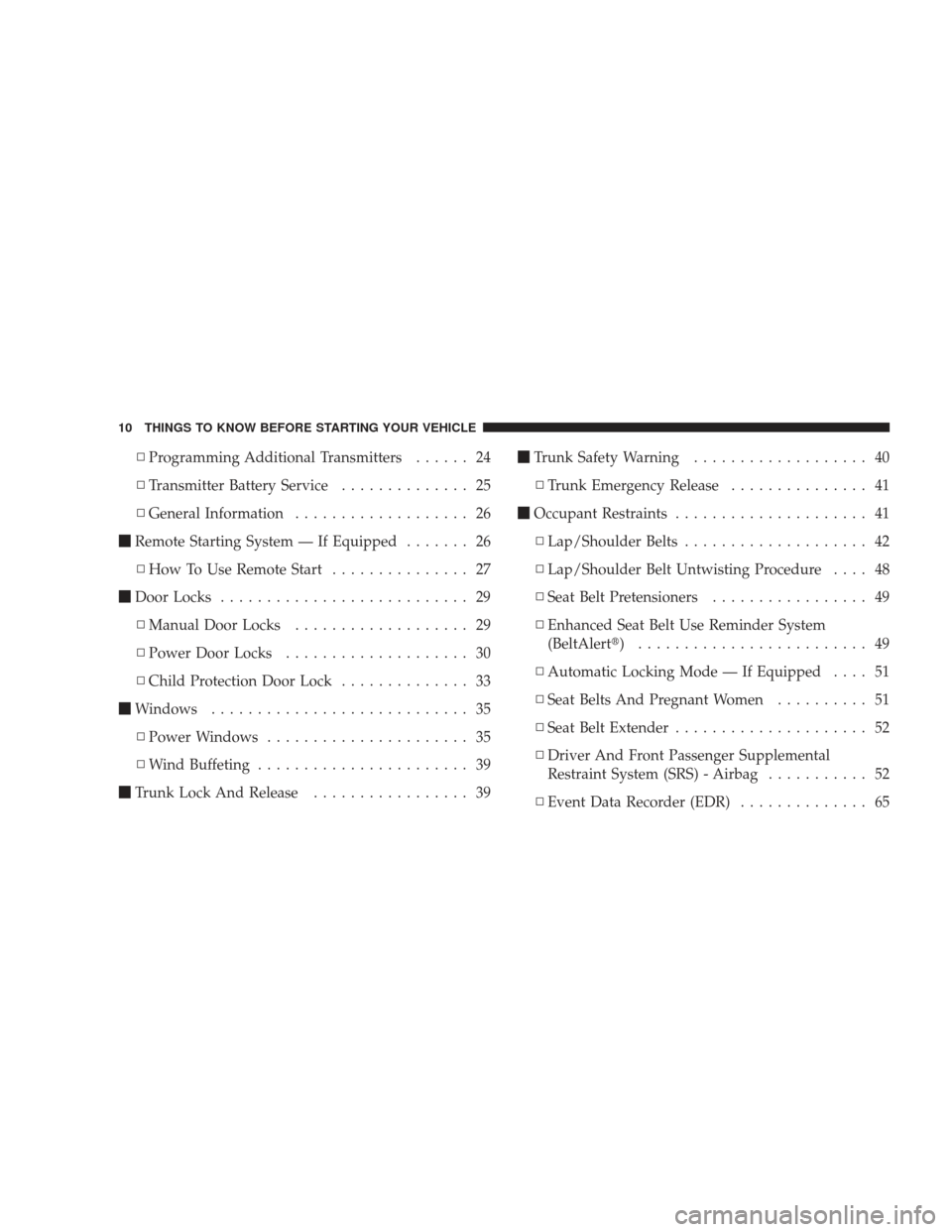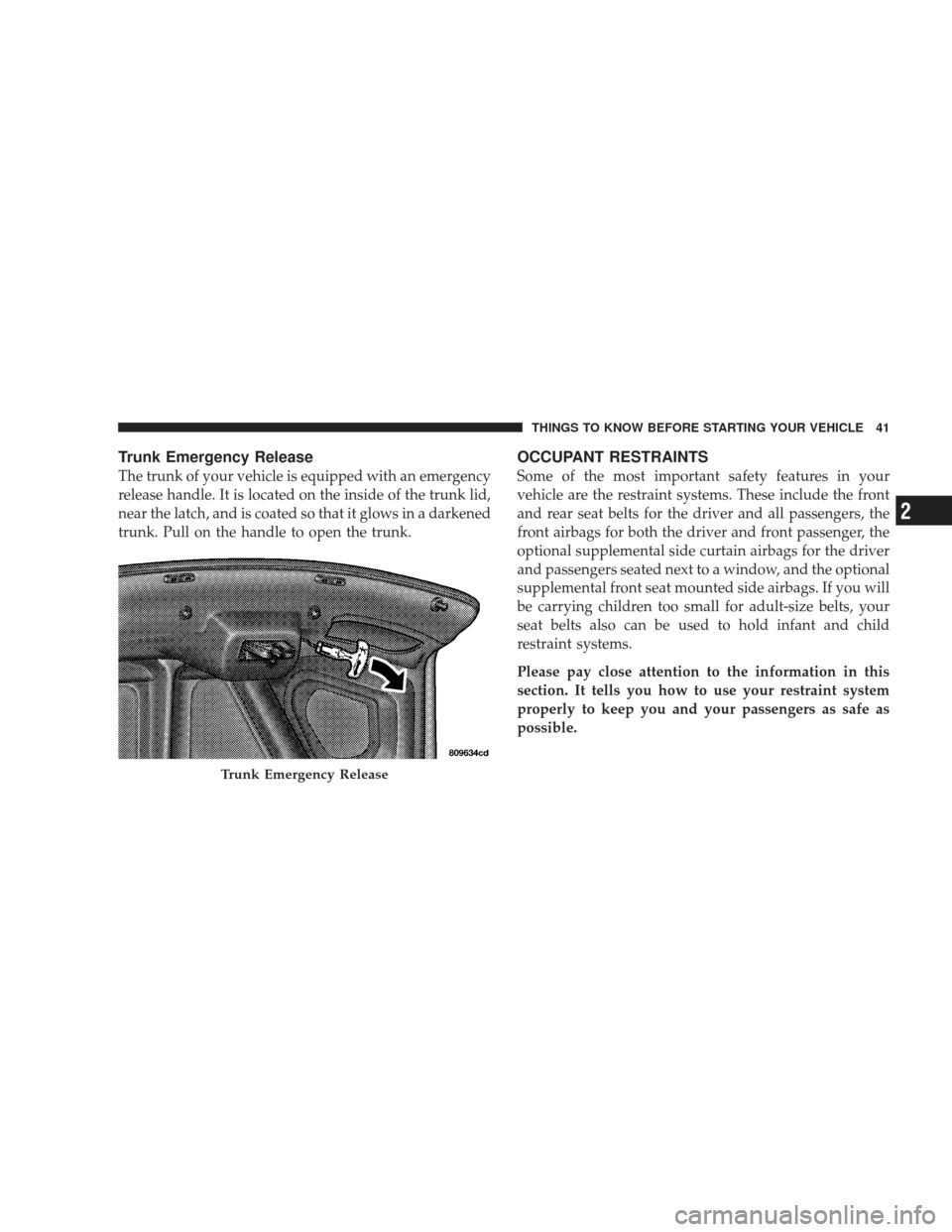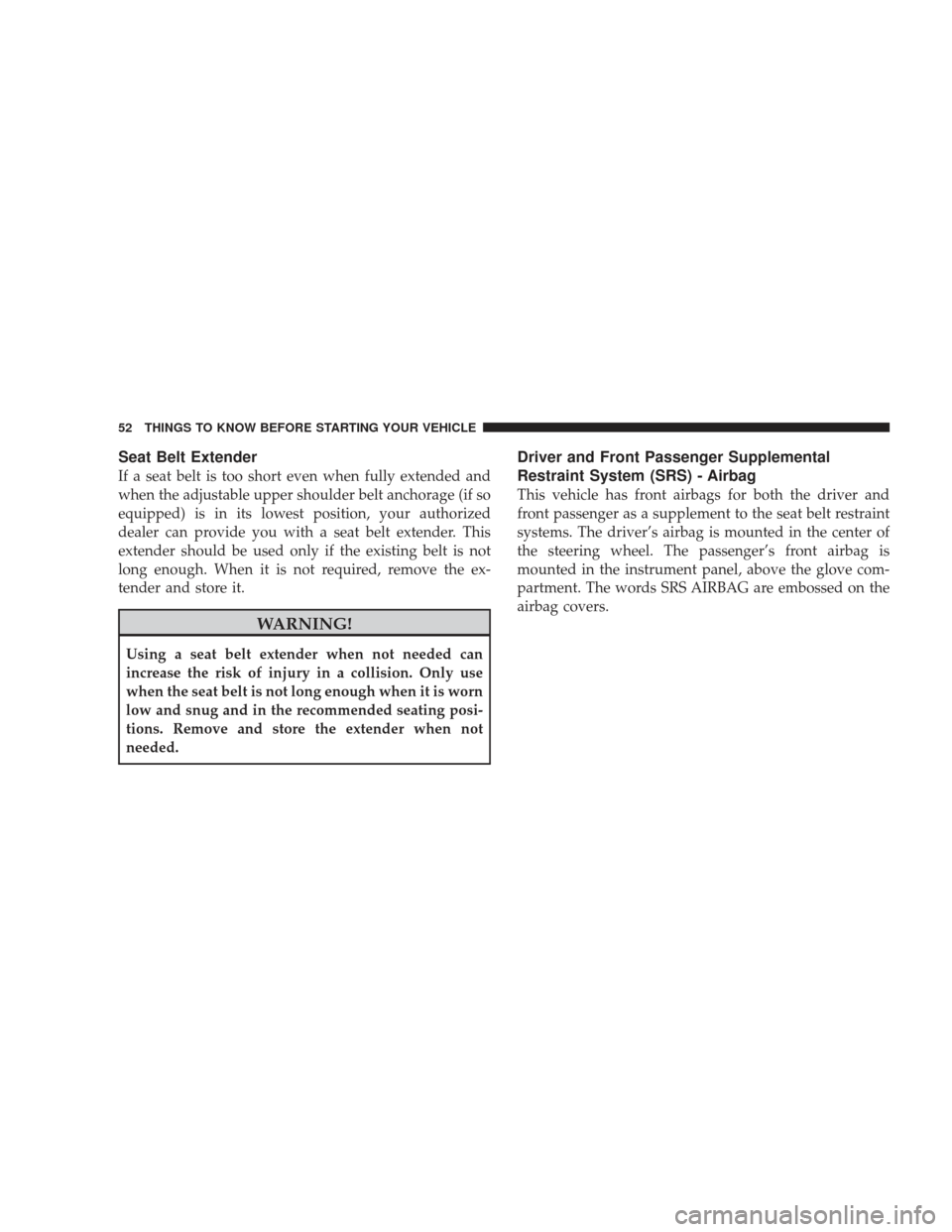Page 12 of 484

▫Programming Additional Transmitters ...... 24
▫ Transmitter Battery Service .............. 25
▫ General Information ................... 26
� Remote Starting System — If Equipped ....... 26
▫ How To Use Remote Start ............... 27
� Door Locks ........................... 29
▫ Manual Door Locks ................... 29
▫ Power Door Locks .................... 30
▫ Child Protection Door Lock .............. 33
� Windows ............................ 35
▫ Power Windows ...................... 35
▫ Wind Buffeting ....................... 39
� Trunk Lock And Release ................. 39 �
Trunk Safety Warning ................... 40
▫ Trunk Emergency Release ............... 41
� Occupant Restraints ..................... 41
▫ Lap/Shoulder Belts .................... 42
▫ Lap/Shoulder Belt Untwisting Procedure .... 48
▫ Seat Belt Pretensioners ................. 49
▫ Enhanced Seat Belt Use Reminder System
(BeltAlert�) ......................... 49
▫ Automatic Locking Mode — If Equipped .... 51
▫ Seat Belts And Pregnant Women .......... 51
▫ Seat Belt Extender ..................... 52
▫ Driver And Front Passenger Supplemental
Restraint System (SRS) - Airbag ........... 52
▫ Event Data Recorder (EDR) .............. 65
10 THINGS TO KNOW BEFORE STARTING YOUR VEHICLE
Page 43 of 484

Trunk Emergency Release
The trunk of your vehicle is equipped with an emergency
release handle. It is located on the inside of the trunk lid,
near the latch, and is coated so that it glows in a darkened
trunk. Pull on the handle to open the trunk.
OCCUPANT RESTRAINTS
Some of the most important safety features in your
vehicle are the restraint systems. These include the front
and rear seat belts for the driver and all passengers, the
front airbags for both the driver and front passenger, the
optional supplemental side curtain airbags for the driver
and passengers seated next to a window, and the optional
supplemental front seat mounted side airbags. If you will
be carrying children too small for adult-size belts, your
seat belts also can be used to hold infant and child
restraint systems.
Please pay close attention to the information in this
section. It tells you how to use your restraint system
properly to keep you and your passengers as safe as
possible.
Trunk Emergency Release
THINGS TO KNOW BEFORE STARTING YOUR VEHICLE 41
2
Page 51 of 484

3. Slide the latch plate upward over the folded webbing.
The folded webbing must enter the slot at the top of the
latch plate.
4. Continue to slide the latch plate up until it clears the
folded webbing.
Seat Belt Pretensioners
The seat belts for both front seating positions are
equipped with pretensioning devices that are designed to
remove any slack from the seat belts in the event of a
collision. These devices improve the performance of the
seat belt system by assuring that the belt is tight around
the occupant in a collision. Pretensioners work for all size
occupants, including those in child restraints.
NOTE:These devices are not a substitute for proper seat
belt placement by the occupant. The seat belt still must be
worn snugly and positioned properly. The pretensioners are triggered by the Occupant Re-
straint Controller (ORC). (Refer to information on Air-
bags in this section). Like the front airbags, the preten-
sioners are single use items. After a collision that is severe
enough to deploy the airbags and pretensioners, both
must be replaced.Enhanced Seat Belt Use Reminder System
(BeltAlert�)
If the driver’s seat belt has not been buckled within
60 seconds of starting the vehicle and if the vehicle speed
is greater than 5 mph (8 km/h), the Enhanced Seat Belt
Use Reminder System (BeltAlert�) will alert the driver to
buckle their seat belt. The driver should also instruct all
other occupants to buckle their seat belts. Once the
warning is triggered, the BeltAlert�
will continue to
chime and flash the Seat Belt Reminder Light for 96 sec-
onds or until the driver’s seat belt is buckled. The
THINGS TO KNOW BEFORE STARTING YOUR VEHICLE 49
2
Page 54 of 484

Seat Belt Extender
If a seat belt is too short even when fully extended and
when the adjustable upper shoulder belt anchorage (if so
equipped) is in its lowest position, your authorized
dealer can provide you with a seat belt extender. This
extender should be used only if the existing belt is not
long enough. When it is not required, remove the ex-
tender and store it.
WARNING!
Using a seat belt extender when not needed can
increase the risk of injury in a collision. Only use
when the seat belt is not long enough when it is worn
low and snug and in the recommended seating posi-
tions. Remove and store the extender when not
needed.
Driver and Front Passenger Supplemental
Restraint System (SRS) - Airbag
This vehicle has front airbags for both the driver and
front passenger as a supplement to the seat belt restraint
systems. The driver’s airbag is mounted in the center of
the steering wheel. The passenger’s front airbag is
mounted in the instrument panel, above the glove com-
partment. The words SRS AIRBAG are embossed on the
airbag covers.
52 THINGS TO KNOW BEFORE STARTING YOUR VEHICLE
Page 55 of 484
NOTE:The front airbags are certified to the Federal
regulations that allow less forceful deployment. The front airbags have a multistage inflator design. This
may allow the airbag to have different rates of inflation
that are based on collision severity.
WARNING!
•Do not put anything on or around the front airbag
covers or attempt to open them. You may damage
the airbags and you could be injured because the
airbags are no longer functional. These protective
covers for the airbag cushions are designed to
open only when the airbags are inflating.
•Do not drill, cut or tamper with the knee bolster in
any way.
•Do not mount any accessories to the knee bolster
such as alarm lights, stereos, citizens band radios
etc.
Front Airbag Components
1 — Airbags
2 — Knee Bolsters THINGS TO KNOW BEFORE STARTING YOUR VEHICLE 53
2
Page 56 of 484
This vehicle may also be equipped with supplemental
side curtain airbags to protect the driver and passengers
sitting next to a window and/or supplemental front
seat-mounted side airbags.
If the vehicle is equipped with supplemental side curtain
airbags, they are located above the side windows. Their
covers are also labeled SRS AIRBAG.NOTE:Airbag covers may not be obvious in the interior
trim, but they will open to allow airbag deployment.
Window Airbag
54 THINGS TO KNOW BEFORE STARTING YOUR VEHICLE
Page 57 of 484
If the vehicle is equipped with supplemental front seat-
mounted side airbags, they are marked with an SRS label
sewn into the outboard side of the seat.WARNING!
•If your vehicle is equipped with supplemental
front seat-mounted side airbags, do not use acces-
sory seat covers or place objects between you and
the seat airbags; the performance could be ad-
versely affected and/or objects could be pushed
into you, causing serious injury.
•If your vehicle is equipped with supplemental
front seat-mounted side airbags, do not attach
cupholders or any other objects on or around the
door. The inflating seat airbag could drive the
object into occupants, causing serious injury.(Continued)
SRS Label Location
THINGS TO KNOW BEFORE STARTING YOUR VEHICLE 55
2
Page 58 of 484

WARNING! (Continued)
•If your vehicle is equipped with supplemental
side curtain airbags, do not stack luggage or other
cargo up high enough to block the location of the
side curtain airbag. The area where the side cur-
tain airbag is located should remain free from any
obstructions.
•If your vehicle is equipped with supplemental
side curtain airbags, do not have any accessory
items installed which will alter the roof, including
adding a sunroof to your vehicle. Do not add roof
racks that require permanent attachments (bolts or
screws) for installation on the vehicle roof. Do not
drill into the roof of the vehicle for any reason.
NOTE: Do not use a clothing bar mounted to the coat
hooks in this vehicle. A clothing bar will impede the
proper performance of the curtain airbags. Along with the seat belts, front airbags work with the
instrument panel knee bolsters to provide improved
protection for the driver and front passenger. Side curtain
and seat airbags also work with seat belts to improve
occupant protection.
While the seat belts are designed to protect you in many
types of collisions, the front airbags will deploy in
moderate to severe frontal collisions. For vehicles so
equipped, the supplemental side curtain airbag and front
seat-mounted side airbag on the crash side of the vehicle
will also trigger in moderate to severe side collisions.
However, even in collisions where the airbags deploy,
you need the seat belts to keep you in the correct position
for the airbags to protect you properly.
Here are some simple steps you can take to minimize
the risk of harm from a deploying airbag.
1. Children 12 years old and younger should ride buck-
led up in the rear seat.
56 THINGS TO KNOW BEFORE STARTING YOUR VEHICLE